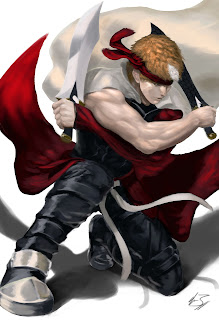There's only one population of giants on Elsai, and it's the cloud giants of the Geralt mountain range, far north of Wundergauss on the continent of Nebelkuste.
These cloud giants stand between 16 and 20 feet tall. Their skin is blue grey. Their hair is white, grey, or charcoal. Their eyes are foggy and dead with glowing white irises. They wear garbs of cloudsilk etched with geometric patterns.
The giants despise Wundergauss and its inhabitants. The reason for this hatred is because the giants are old enough to remember the eldritch horror that lies within the city and how screwed they'll be if it is unleashed.
Giants can also walk on clouds. This is known because their frequent raids on the city begin with squads of giants propelling from the clouds like members of SWAT. The fun ones, known as Berserkers, take the quick way down like drop bombs. Other giants harry ground forces with boulders from atop their cloud platforms.
Despite their hatred for Wundergauss and the other cities of wonder, there exist peaceful giants that wander Elsai. However these giants are always characterized by some form of disfiguration, be it a severed limb, missing eye, or severe scar tissue. These giants never divulge the secret of their maiming, nor are they want to discuss giant culture.
Giant
HD 10
Con 18
Str 18
Weapon 1d10
Boulder d20
Crush - Once per round the giant can squash, swat away, or otherwise obliterate a humanoid size creature. The creature gets a Dex Save to dodge out of the way. Exceptionally strong creatures (Strength 16+) can roll a Str Save instead. Creatures larger than a humanoid are immune.
Hardiness - Convential weaponry only deals a maximum of 1 damage against the giant. Siege weaponry, such as catapults and cannons, deals listed damage.
Cloudfoot - The giant can walk on clouds as if it was a hard surface and takes half damage from falling from great heights.
Giant PCs
Players can opt to play a giant character. Giant PCs get the abilities above in addition to the following:
Giant Ability Scores - Giants apply their bonus twice to Strength Checks when doing "human things" but they leave destruction in their wake.
For example a giant opening a human sized stuck door would apply their bonus twice, leaving the door in splinters and pieces if they succeed.
When doing giant things, such as opening a giant stuck door, the giant only applies their bonus once.
Additionally, giants apply half of their bonus to Dexterity Checks when doing "human things", again leaving destruction in their wake if they succeed, but add their full bonus when doing giant things.
Disfigurations - Giants that don't want to kill humans are horribly disfigured. Therefore giant PCs begin play with d3+1 horrible disfigurations.



